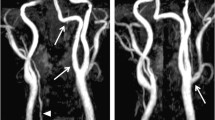Summary
The hypoglossal artery représents a very rare congenital carotid-basilar anastomosis, for 23 cases only have been described fill now. In the present paper the authors (show) a new observation about it as well as five cases of trigeminal arteries. They refer to the angiographic criteria of LIE and SALTZMAN which permit to stablish those arterial anomalies. Though many authors have insisted on the frequency of associated aneurysms and on the occurence of a meningeal hemmorhage as a factor initiating the angiographic study, these two facts have not been found again here. The five patients they describe didn’t either present any trigeminal pain. Considering those six carotid-basilar anastomoses, we can note that they are perfectly well tolarated; being clinically dumb they have been accidentally found (tierce during a vertebro-basilar insufficiency exploration; and three time when searching for a cerebral expansive lesion).
Résumé
L’artère hypoglosse représente une anastomose congénitale carotido-basilaire très rare, puisqu’à ce jour 23 cas seulement en ont été décrits. Les auteurs en rapportent une nouvelle observation ainsi que cinq cas d’artères trigéminées. A cette occasion, ils rappellent les critères angiographiques de LIE et SALTZMAN permettant de reconnaitreeces anomalies artérielles. Alors que de nombreux auteurs ont insisté sur la fréquence d’anévrysmes associés et sur la survenue d’une hémorragie méningée, comme facteur déclenchant l’examen angiographique, ces deux faits n’ont pas été retrouvés ici. De même, aucun des cinq malades ne présentait de névralgies trigéminées. Si l’on considère ces six anastomoses carotido-basilaires, elles sont parfaitement bien tolérées muettes cliniquement; elles ont été découvertes, fortuitement, deux fois lors de l’exploration d’une insuffisance vertebro-basilaire et trois fois lors de la recherche d’une lésion expansive cérébrale.
Zusammenfassung
Fall-Bericht eines Patienten mit einer primitiven A. hypoglossica. Es handelt sich dabei um die 24. Veröffentlichung in der Weltliteratur.
Similar content being viewed by others
References
Dilenge, D., Metzger, J., Constans, J. P.: J. Radiol. Electrol.45, 575 (1964).
Djindjian, R., Hurth, H., Bories, J., Brunet, P.: L’artère trigéminale primitive (aspects artériographiques et signification à propos de 12 cas). Presse Med.73, 2905 (1965).
Lecuire, J., Buffard, P., Goutelle, A., Dechaume, J. P., Michel, D., Tambaud, G., Verger, D.: J. Radiol. Electrol.5, 217 (1965).
Lie, T.A.: The arteria hypoglossica primitiva—Paper read at the 12,1/2th Anniversary Meeting of the Neurosurgical department of the St. Elisabeth Ziekenhuis, Tilburg (1963).
Lie, T.A.: Congenital anomalies of the carotid arteries. Excerpta Medica Foundation (1968).
Padget, D.H.: Centr., Embryol. Carneg. Instit.,212/32, 205 (1948).
Saltzman, G.F.: Acta Radiol. (Stockh.)51, 329 (1959).
Verger, D.: Contribution à l’étude des anastomoses carotido-basilaires (à propos de 15 observations). Lyon: Thèse 1965.
Author information
Authors and Affiliations
Rights and permissions
About this article
Cite this article
Debaene, A., Farnarier, P., Dufour, M. et al. Hypoglossal artery, a rare abnormal carotid-basilar anastomosis. Neuroradiology 4, 233–238 (1972). https://doi.org/10.1007/BF02469136
Issue Date:
DOI: https://doi.org/10.1007/BF02469136




